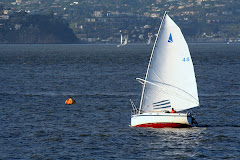Links to earlier blogs in chronological order:
Nonsuch 22 Brochure
Forward looking sonar on Blueberry
MarsKeel stability bulb torpedo on Blueberry
Wyliecat width of wishbone on Blueberry
This blog entry is a step by step documentation of the installation of the Interphase-tech forward looking sonar installed on Blueberry.
The function of the two sonar transducers is explained below. The installation procedures are shown below that.

Total installation time was a couple of hours. The trickiest part was measuring the angle of the hull to work out the cut angle of the fairing block. It is MOST IMPORTANT that you proof your calculations and your table saw settings with a "proof of concept" block of wood before you cut the fairing block. You will see why further down in the pictures below.
The two sonar transducers may be either transom mounted of through hull mounted. The trade offs are this: would you prefer ease of cleaning slime from the transom mounted transducers or having the through hull transducers closer to the pitch center of the boat.
I opted to have the two through hull transducers are mounted reasonably close to the pitch center of the boat. In this installation, the most convenient location was in the port and starboard lockers at the aft end of the two bench seats in the cabin.
A rectangular hole is cut through the floor of the locker. This hole needs to be large enough to install the upper half of the fairing block. This is explained next.
The two transducers ride below the hull just far enough to accomplish two things. First, the transducer has to be vertical to the water surface around the boat. The transducer has to be slightly below the hull to avoid most of the small air bubbles traveling along the hull as the boat move through the water.
To accomplish this, the transducer sits on a fairing block. The fairing block is sawn in half on an angle such that angle of the cut matches the angle of the hull at the installation point.
The picture below shows the cut through the port side locker floor. The cut has to be large enough to allow you to not only tighten the fairing block in place but to fillet the bedding material between the fairing block and the inner surface of the hull.
Back filling the area around the installed fairing block with thickened epoxy to pick up a little extra structural strength from the original locker flooring seems like a good idea to me.

This shows the cut through the starboard locker floor.

The picture below shows the hole sawn though the hull for the transducer stem.

The picture below shows the port side black colored transducer, the bronze transducer stem, with the stem and the transducer lead threaded through the outside half of the sawn transducer block.

The picture below shows the starboard side black colored transducer, the bronze transducer stem, with the stem and the transducer lead threaded through the outside half of the sawn transducer block. Notice there are two leads from the starboard transducer, one for the vertical beam transducer, and the other for the starboard 90 degree horizontal sweep beam.

The picture below shows the Sikaflex bedding compound between the transducer and the bearing block.

The picture below shows the Sikaflex bedding compound being applied to the upper surface of the starboard fairing block and the stem of the transducer.
The guy applying the goop is Dan Jones, who runs Marine Technical Services out of shop space in the Grand Marina of Alameda CA. Dan can be reached on his cell phone at 510-913-0022.
Dan has a wood working shop that those passionate about fine woodworking will truly appreciate. He made the calculation and cutting of the fairing blocks to fit the angle of the hull look easy. It was Dan who convinced me that it is MOST IMPORTANT that you proof your calculations and your table saw settings with a "proof of concept" block of wood before you cut the fairing block. Having a high end table saw capable of precision cuts makes the process quick and easy, though I suspect Dan is skillful enough with wood working that he could have made the cuts with a hand saw.

The picture below shows the Sikaflex bedding compound being applied to the lower surface of the upper half of the fairing block inside the hull.

The picture below shows the two transducers as seen from the bow of the boat.

The picture below shows the starboard side transducer and the fat, outer side of the tapered fairing block.

The picture below shows the two transducers from the stern.

The picture below shows the hole behind, and to one side of the keel for an Airmar Triducer for speed, temperature and depth. The hole is offset to one side and about three feet behind the keel to reduce the effects of keel turbulence on the transducer.

The picture below shows the location of the Triducer hole from he starboard side






